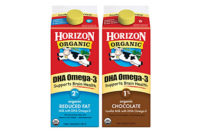

It is important to note that only DHA and EPA contribute to the many health benefits associated with consuming omega-3 fatty acids. ALA can be converted into DHA and EPA, however, the body converts it rather inefficiently and with much variance among consumers based on external and internal factors.
A study published in the March 2009 issue of Journal of Nutrition (139:3; 528-532) found that most Canadian children are deficient in the omega-3 fatty acids DHA and EPA. Specifically, the study found that 78% of the children trialed were not receiving adequate amounts of DHA and EPA in their diets.
Researchers from the University of Guelph, Ontario, Canada, found that the median daily consumption of DHA and EPA was only 31.5 milligrams in a sample group of four to eight year olds. In this study researchers used the suggested daily intake recommended by the Institute of Medicine, which is only 90 milligrams.
The study also notes that the recommendation by the American Dietician Association and the Dieticians of Canada is 351 milligrams of DHA and EPA per day. Based on this recommendation 90% of the children in the study were deficient in these critical developmental fatty acids.
The U.S. Department of Health and Human Services indicates that in the United States the average daily consumption of DHA and EPA for children four to eight years of age is only 50 milligrams. Therefore, although the study only involved Canadian children, we know that American children are also well below the recommended levels.
What we also know is that DHA and EPA omega-3 fatty acids are essential at all stages of life. For infants up to age 3, DHA is essential for the development of the brain and eyes. After age 3, both DHA and EPA are important for cognitive function, and research suggests that these fatty acids may improve behavior and learning disorders, including attention deficit hyperactivity disorder (ADHD) and developmental coordination disorder (DCD). Additionally research indicates that EPA and DHA may reduce inflammatory conditions such as asthma, childhood depression and reduce the risk of Type-1 diabetes.
The researchers from Guelph University stated in their paper that there is an apparent need to create greater awareness of the importance of the long-chain omega-3 polyunsaturated fatty acids among health professionals and the general public, as well as the existing gap between actual and recommended intakes from various sources. This gap can be readily filled with an increased consumption of fish and seafood containing DHA and EPA, the increased availability of foods that have been nutritionally enriched with various delivery forms of DHA and EPA, and the use of supplementation where necessary. “For many years now infant formula has been supplemented with DHA so many parents are already aware of the health benefits associated with omega-3 for their children,” says Dr. William Sears, associate clinical professor of pediatrics, University of California, Irvine, School of Medicine.
As is apparent from the new products reviewed in this month’s article, the majority of omega-3-enhanced introductions are targeted to children. This is logical, because as Sears mentions, parents are aware of the benefits children reap when they consume omega-3-rich foods.
Dairy is the ideal delivery vehicle of omega-3 ingredients for this demographic, as most children milk, yogurt and cheese. These products also inherently contain key nutrients that children require for proper growth and development.


